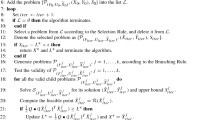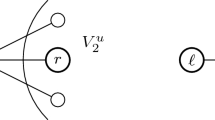Abstract
In this paper, we show a branch-and-cut approach to solve the minimum spanning tree problem with conflicting edge pairs. This is a NP-hard variant of the classical minimum spanning tree problem, in which there are mutually exclusive edges. We introduce a new set of valid inequalities for the problem, based on the properties of its feasible solutions, and we develop a branch-and-cut algorithm based on them. Computational tests are performed both on benchmark instances coming from the literature and on some newly proposed ones. Results show that our approach outperforms a previous branch-and-cut algorithm proposed for the same problem.



Similar content being viewed by others
References
Carrabs, F., Cerrone, C., & Pentangelo, R. (2017). A multi-ethnic genetic approach for the minimum conflict weighted spanning tree problem. submitted to Networks.
Darmann, A., Pferschy, U., & Schauer, J. (2009). Determining a minimum spanning tree with disjunctive constraints. Lecture Notes in Computer Science (including subseries Lecture Notes in Artificial Intelligence and Lecture Notes in Bioinformatics) 5783 LNAI, 414–423.
Darmann, A., Pferschy, U., Schauer, J., & Woeginger, G. (2011). Paths, trees and matchings under disjunctive constraints. Discrete Applied Mathematics, 159(16), 1726–1735.
Gerards, A. M. H., & Schrijver, A. (1986). Matrices with the Edmonds–Johnson property. Combinatorica, 6(4), 365–379.
Oncan, T., Zhang, R., & Punnen, A. (2013). The minimum cost perfect matching problem with conflict pair constraints. Computers and Operations Research, 40(4), 920–930.
Padberg, M., & Wolsey, L. (1983). Trees and cuts. North-Holland Mathematics Studies, 75(C), 511–517.
Pferschy, U., & Schauer, J. (2009). The knapsack problem with conflict graphs. Journal of Graph Algorithms and Applications, 13(2), 233–249.
Pferschy, U., & Schauer, J. (2013). The maximum flow problem with disjunctive constraints. Journal of Combinatorial Optimization, 26(1), 109–119.
Sadykov, R., & Vanderbeck, F. (2013). Bin packing with conflicts: A generic branch-and-price algorithm. INFORMS Journal on Computing, 25(2), 244–255.
Samer, P., & Urrutia, S. (2014). A branch and cut algorithm for minimum spanning trees under conflict constraints. Optimization Letters, 9(1), 41–55.
Zhang, R., Kabadi, S., & Punnen, A. (2011). The minimum spanning tree problem with conflict constraints and its variations. Discrete Optimization, 8(2), 191–205.
Author information
Authors and Affiliations
Corresponding author
Rights and permissions
About this article
Cite this article
Carrabs, F., Cerulli, R., Pentangelo, R. et al. Minimum spanning tree with conflicting edge pairs: a branch-and-cut approach. Ann Oper Res 298, 65–78 (2021). https://doi.org/10.1007/s10479-018-2895-y
Published:
Issue Date:
DOI: https://doi.org/10.1007/s10479-018-2895-y




